The kinetically dominant assembly pathway for centrosomal asters in Caenorhabditis elegans is gamma-tubulin dependent
- PMID: 12011109
- PMCID: PMC2173857
- DOI: 10.1083/jcb.200202047
The kinetically dominant assembly pathway for centrosomal asters in Caenorhabditis elegans is gamma-tubulin dependent
Abstract
gamma-Tubulin-containing complexes are thought to nucleate and anchor centrosomal microtubules (MTs). Surprisingly, a recent study (Strome, S., J. Powers, M. Dunn, K. Reese, C.J. Malone, J. White, G. Seydoux, and W. Saxton. Mol. Biol. Cell. 12:1751-1764) showed that centrosomal asters form in Caenorhabditis elegans embryos depleted of gamma-tubulin by RNA-mediated interference (RNAi). Here, we investigate the nucleation and organization of centrosomal MT asters in C. elegans embryos severely compromised for gamma-tubulin function. We characterize embryos depleted of approximately 98% centrosomal gamma-tubulin by RNAi, embryos expressing a mutant form of gamma-tubulin, and embryos depleted of a gamma-tubulin-associated protein, CeGrip-1. In all cases, centrosomal asters fail to form during interphase but assemble as embryos enter mitosis. The formation of these mitotic asters does not require ZYG-9, a centrosomal MT-associated protein, or cytoplasmic dynein, a minus end-directed motor that contributes to self-organization of mitotic asters in other organisms. By kinetically monitoring MT regrowth from cold-treated mitotic centrosomes in vivo, we show that centrosomal nucleating activity is severely compromised by gamma-tubulin depletion. Thus, although unknown mechanisms can support partial assembly of mitotic centrosomal asters, gamma-tubulin is the kinetically dominant centrosomal MT nucleator.
Figures
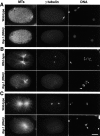
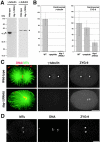
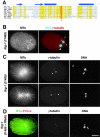
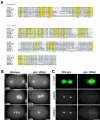
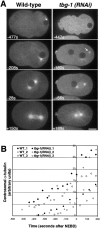


Similar articles
-
Human Cep192 is required for mitotic centrosome and spindle assembly.Curr Biol. 2007 Nov 20;17(22):1960-6. doi: 10.1016/j.cub.2007.10.019. Epub 2007 Nov 1. Curr Biol. 2007. PMID: 17980596
-
Aurora-A kinase is required for centrosome maturation in Caenorhabditis elegans.J Cell Biol. 2001 Dec 24;155(7):1109-16. doi: 10.1083/jcb.200108051. Epub 2001 Dec 17. J Cell Biol. 2001. PMID: 11748251 Free PMC article.
-
Elongation of centriolar microtubule triplets contributes to the formation of the mitotic spindle in gamma-tubulin-depleted cells.J Cell Sci. 2004 Nov 1;117(Pt 23):5497-507. doi: 10.1242/jcs.01401. Epub 2004 Oct 12. J Cell Sci. 2004. PMID: 15479719
-
Microtubule nucleation: gamma-tubulin and beyond.J Cell Sci. 2006 Oct 15;119(Pt 20):4143-53. doi: 10.1242/jcs.03226. J Cell Sci. 2006. PMID: 17038541 Review.
-
The relative roles of centrosomal and kinetochore-driven microtubules in Drosophila spindle formation.Exp Cell Res. 2012 Jul 15;318(12):1375-80. doi: 10.1016/j.yexcr.2012.05.001. Epub 2012 May 8. Exp Cell Res. 2012. PMID: 22580224 Review.
Cited by
-
UNC-89 (obscurin) binds to MEL-26, a BTB-domain protein, and affects the function of MEI-1 (katanin) in striated muscle of Caenorhabditis elegans.Mol Biol Cell. 2012 Jul;23(14):2623-34. doi: 10.1091/mbc.E12-01-0055. Epub 2012 May 23. Mol Biol Cell. 2012. PMID: 22621901 Free PMC article.
-
spe-10 encodes a DHHC-CRD zinc-finger membrane protein required for endoplasmic reticulum/Golgi membrane morphogenesis during Caenorhabditis elegans spermatogenesis.Genetics. 2006 Jan;172(1):145-58. doi: 10.1534/genetics.105.047340. Epub 2005 Sep 2. Genetics. 2006. PMID: 16143610 Free PMC article.
-
NEDD1-dependent recruitment of the gamma-tubulin ring complex to the centrosome is necessary for centriole duplication and spindle assembly.J Cell Biol. 2006 Feb 13;172(4):505-15. doi: 10.1083/jcb.200510028. Epub 2006 Feb 6. J Cell Biol. 2006. PMID: 16461362 Free PMC article.
-
Mutations in a beta-tubulin disrupt spindle orientation and microtubule dynamics in the early Caenorhabditis elegans embryo.Mol Biol Cell. 2003 Nov;14(11):4512-25. doi: 10.1091/mbc.e03-01-0017. Epub 2003 Aug 22. Mol Biol Cell. 2003. PMID: 12937270 Free PMC article.
-
CAMSAP2 organizes a γ-tubulin-independent microtubule nucleation centre through phase separation.Elife. 2022 Jun 28;11:e77365. doi: 10.7554/eLife.77365. Elife. 2022. PMID: 35762204 Free PMC article.
References
-
- Alberts, B., D. Bray, J. Lewis, M. Raff, K. Roberts, and J. Watson. 1994. Molecular Biology of the Cell. Garland Publishing, Inc., New York. 1294 pp.
Publication types
MeSH terms
Substances
LinkOut - more resources
Full Text Sources
Molecular Biology Databases

